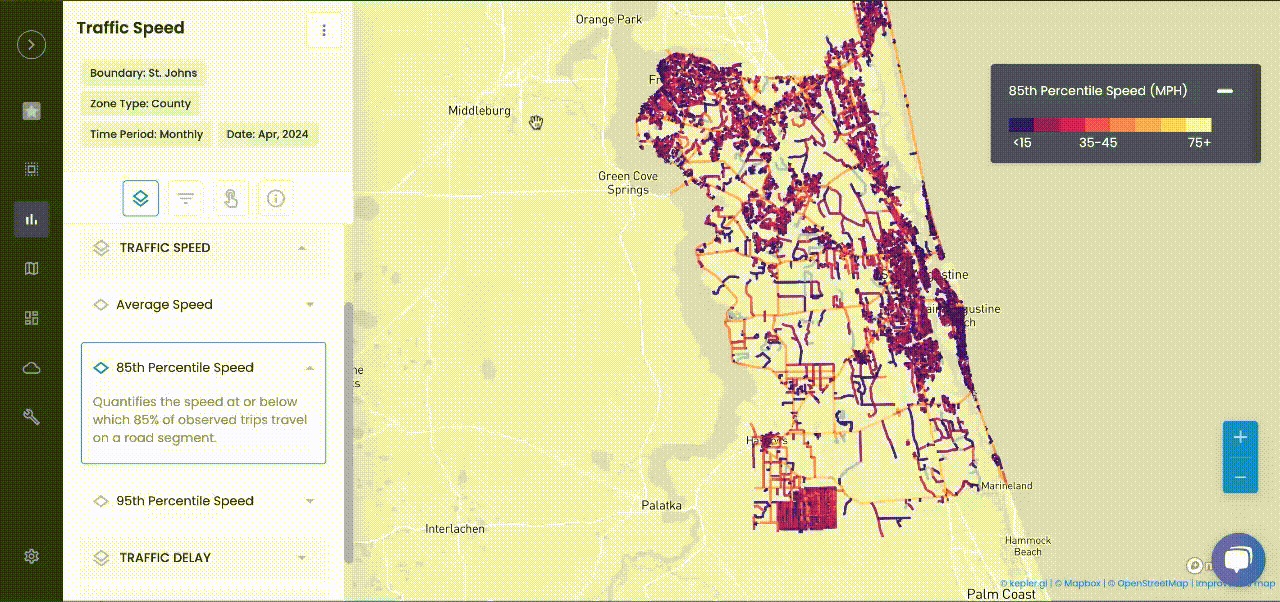
Transportation Planning
Why AI-Powered Roadway Inventories Are the Future of Urban Planning
How AI and geospatial data are supplementing manual road surveys
Discover how AI and geospatial data are supplementing manual road surveys. Urban SDK enables faster, accurate roadway inventories for smart city planning.
Urban SDK is leading the next evolution of roadway inventory through artificial intelligence and geospatial data. Traditionally, transportation departments relied on field crews equipped with measuring wheels, clipboards, and vehicles to gather data on lane widths, signs, and pavement markings. While this method offered accuracy, it was slow, costly, and often left cities with outdated datasets. Today, AI-powered roadway inventories are revolutionizing this approach by using computer vision and machine learning on satellite, aerial, or street-level imagery to automatically identify road features at scale.
With Urban SDK's Roadway Characteristics dataset, users can leverage AI and satellite imagery to efficiently survey roads, curbs, signals, signage, and more—reducing years of manual work to hours. The fusion of AI with geospatial intelligence (GeoAI) enables municipalities to capture and update road networks consistently, regardless of their complexity. In a California pilot, for example, AI systems mapped thousands of miles of sidewalk 45 times faster than traditional methods, demonstrating transformative time savings.
Traditional vs. AI-Powered Approaches
Manual GIS Surveying
Transportation agencies have long gathered roadway data through manual surveying. Crews walk or drive roadways, using measuring tools and notebooks to log data.
Although reliable, this method covers limited ground each year and often results in outdated information.
Mobile Mapping Systems
Some cities have adopted lidar-equipped or camera-mounted vehicles that scan roads while driving.
This enhances data capture but still requires considerable manual processing, such as reviewing video footage to identify features.
AI-Powered Automation
Urban SDK and similar platforms revolutionize this process. By processing aerial or satellite imagery through AI models, these tools automatically extract attributes like lane widths, surface types, pavement conditions, and signage.
The result is a scalable, repeatable, and current dataset that updates with new imagery.
Benefits of AI-Powered Roadway Inventories
Cost Savings
Automating road data collection slashes labor and equipment costs. One customer saved over $80,000 by replacing a traditional multi-year manual survey with an AI system.
Urban SDK's solution reduces the need for field crews and specialized vehicles, allowing even smartphones to aid data collection.
Improved Accuracy
AI systems ensure consistency by applying the same recognition logic across every road segment. They can identify subtle defects, faded markings, and missing signs that human surveyors might overlook.
Platforms like Vaisala's RoadAI perform inspections at highway speeds with accuracy comparable to traditional methods.
Time Efficiency
With AI, months of data collection can be compressed into weeks. In states like California and North Carolina, AI tools digitized entire road networks in record time.
Urban SDK allows departments to maintain up-to-date maps and eliminate long backlogs.
Enhanced Safety
Detailed inventories feed directly into safety models. Urban SDK's Collision Index uses AI-extracted roadway data to identify high-risk segments, allowing cities to act proactively.
Automated systems also flag missing or worn infrastructure faster, improving pedestrian and driver safety.
Smart City Integration
AI-generated road inventories are delivered as georeferenced GIS layers that integrate seamlessly with city systems.
Urban SDK's datasets work alongside traffic sensors, asset management platforms, and public dashboards, enabling real-time planning and transparency.
Key Use Cases
Asset Management and Planning
A complete inventory of road assets—from signals to sidewalks—is foundational for infrastructure planning. Urban SDK's platform enables cities to use validated data in order to schedule upgrades and align budgets with up-to-date asset maps.
Road Maintenance
By continuously analyzing new imagery, Urban SDK provides a quick way to identify road deterioration, potholes, and faded markings before they become hazards. Predictive maintenance planning becomes feasible and cost-effective.
Traffic Safety Analysis
Precise road geometry and signage data enhances crash modeling.
Urban SDK's Speed Limit Difference tool compares mapped speed limits with real driving speeds to identify enforcement gaps.
Mobility and Accessibility Planning
AI-derived maps show the locations of bike lanes, ADA ramps, sidewalks, and transit stops—critical for inclusive planning.
In one project, AI tools mapped 16 road features, including medians and turn lanes, enabling smarter route design and improved pedestrian safety.
Urban SDK's AI-Driven Platform
Urban SDK offers an advanced platform for automated roadway inventories. Its Roadway Characteristics product uses satellite imagery and AI to deliver comprehensive, 3D road geometry and facility data. Municipal leaders can view, analyze, and download this data via Urban SDK's dashboard.
This geospatial AI solution covers everything from lane counts to sidewalk availability, and it integrates directly into existing GIS platforms. Urban SDK's platform also incorporates live traffic and safety data, delivering a 360-degree view of urban mobility.
Urban SDK's slogan—"Own the road forward with geospatial AI"—captures this mission. Whether updating signage locations, analyzing speed trends, or planning equitable infrastructure investments, Urban SDK equips planners with data they can act on.
Conclusion
AI-powered roadway inventories represent the future of urban infrastructure planning. Urban SDK demonstrates how combining satellite imagery, AI, and GIS can deliver comprehensive, up-to-date, and actionable roadway data. This shift from manual to automated inventory enables faster maintenance, safer streets, and smarter planning. Cities that embrace this technology will be better equipped to serve their communities, cut costs, and build resilient, future-ready road networks.
FAQs
Q1: What is an AI-powered roadway inventory, and how does it differ from traditional surveys?
Ans: AI-powered roadway inventories use artificial intelligence and geospatial data to automatically extract and update road features - like lanes, signs, curbs, and sidewalks - from aerial, satellite, or street-level imagery. Unlike manual surveys that require field crews and are slow and costly, AI automates the process, yielding faster and more current results.
Q2: What are the key benefits of AI-powered roadway inventories for cities?
Ans: The main benefits include major cost savings by reducing labor and equipment needs, improved accuracy and consistency in identifying road features, faster data collection that keeps networks up-to-date, enhanced safety through rapid detection of hazards, and seamless integration with smart city planning tools and dashboards.
Q3: How does AI improve the accuracy and consistency of road data collection?
Ans: AI systems use computer vision and machine learning to apply the same recognition logic to every road segment, reducing human error while detecting subtle issues (like faded markings or missing signs) that field surveys might overlook. This ensures uniform, high-quality datasets across large networks.
Q4: How does AI-powered road mapping enhance urban planning and asset management?
Ans: Automated, georeferenced inventories integrate directly into city GIS systems, enabling real-time planning, traffic modeling, maintenance scheduling, and transparent public reporting. Planners can track asset lifecycles, prioritize upgrades, and align budgets with current and accurate asset maps.
Q5: What impact does AI-driven inventory have on road maintenance and safety?
Ans: Continuous analysis of new imagery allows cities to quickly identify and prioritize repairs for pavement deterioration, faded markings, and missing infrastructure. This preventive approach enables cost-effective maintenance and improves pedestrian and driver safety before issues escalate.
Q6: How do AI-powered inventories support inclusive mobility and accessibility planning?
Ans: AI can automatically map essential infrastructure - such as bike lanes, ADA ramps, transit stops, and sidewalks - so cities can better design routes that are safe and accessible for all users. This supports equitable planning and compliance with modern standards.
Q7: How much faster and cost-effective is AI-driven mapping compared to manual surveys?
Ans: In real-world pilots, AI mapping delivered inventories up to 45 times faster than manual methods, saving cities tens of thousands of dollars. What once took months or years with ground crews can now be done in weeks, often using just imagery and data integration tools.
Q8: Can AI mapping seamlessly integrate with existing smart city platforms?
Ans: Yes, AI-derived road inventories are delivered as GIS-compatible data layers that integrate with asset management platforms, traffic sensors, and public dashboards - empowering smarter, real-time decision-making and transparent reporting for city stakeholders.

TRAFFIC ENFORCEMENT FEATURES
80% of citizen complaints
are a perception problem
Urban SDK provides precise hourly speed data to evaluate complaints and deploy resources efficiently for the greatest impact to public safety.
Urban SDK provides precise hourly speed data to evaluate complaints and deploy resources efficiently for the greatest impact to public safety.
Target Speeding
Identify hot spots, validate monthly speeding trends and monitor vulnerable areas like school zones.
Improve Safety
Crash and citations location information to compare speed trends month over month
Fast Response
Respond to citizen complaints sooner with address search and exportable reporting
Deploy Assets
Generate maps for traffic enforcement by time of day, location or division to deploy officers to known problem areas.
RESOURCES
Customer Success
See how public sector leaders succeed with Urban SDK.
WEBINAR
Identify speeding and proactively enforce issues
See just how quick and easy it is to identify speeding, address complaints, and deploy officers.







